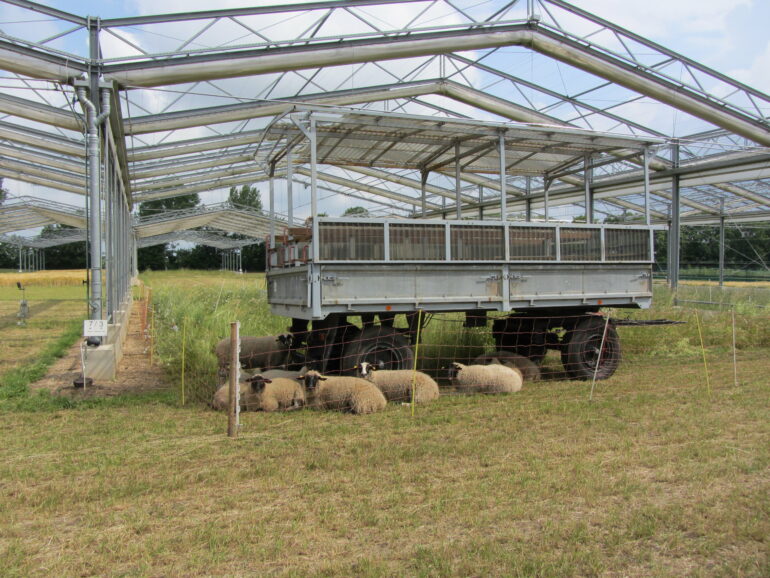A novel study published in Nature Communications found that agroecosystems in Central Germany, specifically grasslands and croplands, may have an enhanced capacity to provide multiple goods and services simultaneously when land management reduces the use of pesticides and mineral nitrogen fertilizer.
This finding holds true under potential future climate conditions, with soil biodiversity expected to be a significant element of so-called multifunctionality, according to researchers at the German Center for Integrative Biodiversity Research (iDiv), the Helmholtz Center for Environmental Research (UFZ), Leipzig University, and the Martin Luther University Halle-Wittenberg (MLU).
The study is also the first to employ mixed ecological-economic multifunctionality measures that take into account the preferences of stakeholders for different ecosystem services. For instance, farmers put a higher value on food productivity than other stakeholders. In addition, society as a whole benefits from regulating services like carbon sequestration, and the preservation of water quality.
To date, considerable debate exists about the ideal farming method that aligns with society’s varied values. Intensive farming uses mineral fertilizers and synthetic pesticides to increase yields, while extensive farming avoids agrochemicals. Each comes with trade-offs: Intensive farming can increase yields but may pollute, whereas extensive farming might require more land due to lower yields per unit area.
“The unique study design enabled us to assess the effects of major global change drivers, such as climate and land-use change, on ecosystem service provision,” says first author Friedrich Scherzinger, alumnus of iDiv and Leipzig University. Scherzinger led the study for his master’s thesis at Leipzig University and the University of Graz. “These ecosystem services are essential for human well-being. Combining both economic and ecological research provides a more holistic view of interconnected parts of the ecosystem.”
Integrating ecology and economics from the start
The researchers used a large-scale field experiment with five land-use types under two different climate scenarios (current and potential future climate): the Global Change Experimental Facility (GCEF), operated by the UFZ.
The ecological multifunctionality portion of the assessment explored 14 ecosystem functions, such as nitrogen leaching and aboveground biomass production; whereas the economic multifunctionality assessment incorporated the total financial value of the resulting six ecosystem services: food production, climate regulation, water quality, soil health, biodiversity conservation, and landscape aesthetics.
“The Global Change Experimental Facility is a unique experiment,” says co-author and GCEF coordinator Dr. Martin Schädler, ecologist at UFZ and iDiv.
“It allows us to directly compare the responses of different land-use types to climate change under standardized conditions without confounding effects of differing site conditions. This is especially important for contrasting intensive with extensive production systems which, in the real world, are often established under very different settings.”
By integrating the preferences of farmers, local residents, environmental conservation agencies, and tourism agencies for different ecosystem services from the outset, the researchers offer a more comprehensive assessment of ecosystem services that overcomes the shortcomings of a purely economic valuation.
“Higher biodiversity levels stabilize biomass yields and make them more resilient to disturbances, similar to a diversified stock portfolio,” says Prof Martin Quaas, economist at iDiv and Leipzig University, and senior author of the study. “Based on this effect, we could calculate a natural insurance value of biodiversity.”
The findings suggest that future climate and intensive management reduce ecological multifunctionality for both grasslands and croplands. Overall, the economic multifunctionality measure is approximately 1.7 to 1.9 times higher for extensive management compared to intensive management, and this applies to both grasslands and croplands.
However, when considering only farmers’ preferences, intensively managed grasslands exhibit higher multifunctionality than those without. The study’s results are based on measurements per unit area, but they were not evaluated based on the amount of yield produced.
Linking soil biodiversity to ecosystem services
The study also explored the relationship between soil biodiversity (the variety of life in the soil) and ecological multifunctionality across land-use types and under current and potential future climate conditions.
The findings suggest that soil biodiversity might be an important part of the ecosystem’s ability to perform multiple functions simultaneously, and that ecosystems with low soil biodiversity might be particularly vulnerable to future climate conditions.
“Roughly 60% of all species on Earth live in the soil. These soil creatures are not only incredibly diverse but are the functional backbone of our ecosystems,” explains Prof Nico Eisenhauer, soil ecologist at iDiv and Leipzig University, and senior author of the study.
“The study indicates that we can maintain soil biodiversity through targeted management strategies to sustain the multiple services that nature provides to us.”
The study is an essential step towards a holistic and comprehensive approach, with the authors cautioning against a significant decrease in the benefits society derives from land due to climate change, biodiversity loss, and heavy use of agrochemicals.
“Our study reveals that farmers maximize their income through intensive management, while ecosystem service provision is highest under extensive management,” says Scherzinger.
“Since farmers are traditionally the ones managing the land, societal benefit cannot be optimal without a system that incentivizes farmers in a way that their income gap between intensive and extensive management is bridged.”
However, relevant aspects, such as landscape diversity and land footprint (the area needed per unit yield), were not considered in this study, making it difficult to draw conclusions as to what type of agriculture is ultimately the best fit for purpose.
“Future research should focus on landscape-level ecosystem service provision and the role of landscape heterogeneity for optimal societal outcome,” Scherzinger concludes.
More information:
Friedrich Scherzinger et al, Sustainable land management enhances ecological and economic multifunctionality under ambient and future climate, Nature Communications (2024). DOI: 10.1038/s41467-024-48830-z
Provided by
German Centre for Integrative Biodiversity Research (iDiv) Halle-Jena-Leipzig
Citation:
Land management and climate change affect ecosystems’ ability to provide multiple services simultaneously, study shows (2024, June 14)



